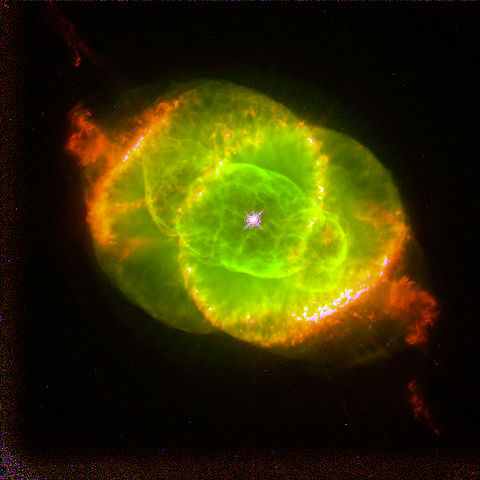 |
This is a file from the Wikimedia Commons. Information from its description page there is shown below.
Commons is a freely licensed media file repository. You can help.
|
| Description |
English: This NASA Hubble Space Telescope image shows one of the most complex planetary nebulae ever seen, NGC 6543, nicknamed the "Cat's Eye Nebula."Hubble reveals surprisingly intricate structures including concentric gas shells, jets of high-speed gas and unusual shock-induced knots of gas. Estimated to be 1,000 years old, the nebula is a visual "fossil record" of the dynamics and late evolution of a dying star.
A preliminary interpretation suggests that the star might be a double-star system. The suspected companion star also might be responsible for a pair of high-speed jets of gas that lie at right angles to this equatorial ring. If the companion were pulling in material from a neighboring star, jets escaping along the companion's rotation axis could be produced.
These jets would explain several puzzling features along the periphery of the gas lobes. Like a stream of water hitting a sand pile, the jets compress gas ahead of them, creating the "curlicue" features and bright arcs near the outer edge of the lobes. The twin jets are now pointing in different directions than these features. This suggests the jets are wobbling, or precessing, and turning on and off episodically.
This colour picture, taken with the Wide Field Planetary Camera-2, is a composite of three images taken at different wavelengths. (red, hydrogen-alpha; blue, neutral oxygen, 6300 angstroms; green, ionized nitrogen, 6584 angstroms). The image was taken on September 18, 1994. NGC 6543 is 3,000 light-years away in the northern constellation Draco. The term planetary nebula is a misnomer; dying stars create these cocoons when they lose outer layers of gas. The process has nothing to do with planet formation, which is predicted to happen early in a star's life.
|
| Date |
18 September 1994 |
| Source |
Great Images in NASA Description |
| Author |
NASA J.P.Harrington and K.J.Borkowski University of Maryland |
Permission
( Reusing this file) |
| Public domainPublic domainfalsefalse |
 |
This file is in the public domain because it was solely created by NASA. NASA copyright policy states that "NASA material is not protected by copyright unless noted". (See Template:PD-USGov, NASA copyright policy page or JPL Image Use Policy.) |
|
|
|
Warnings:
- Use of NASA logos, insignia and emblems are restricted per US law 14 CFR 1221.
- The NASA website hosts a large number of images from the Soviet/ Russian space agency, and other non-American space agencies. These are not necessarily in the public domain.
- Materials based on Hubble Space Telescope data may be copyrighted if they are not explicitly produced by the STScI. See also {{ PD-Hubble}} and {{ Cc-Hubble}}.
- The SOHO (ESA & NASA) joint project implies that all materials created by its probe are copyrighted and require permission for commercial non-educational use.
- Images featured on the Astronomy Picture of the Day (APOD) web site may be copyrighted.
|
|
 |
This image or video was catalogued by Hubble Space Telescope Institute of the United States National Aeronautics and Space Administration (NASA) under Photo ID: GPN-2000-000955 AND Alternate ID: PRC95-01A.
This tag does not indicate the copyright status of the attached work. A normal copyright tag is still required. See Commons:Licensing for more information.
|
File usage
The following pages on Schools Wikipedia link to this image (list may be incomplete):
Through Schools Wikipedia, SOS Children's Villages has brought learning to children around the world. Our 500 Children's Villages provide a home for thousands of vulnerable children. Beyond our Villages, we support communities, helping local people establish better schools and delivering effective medical care to vulnerable children. If you'd like to help, learn how to sponsor a child.





